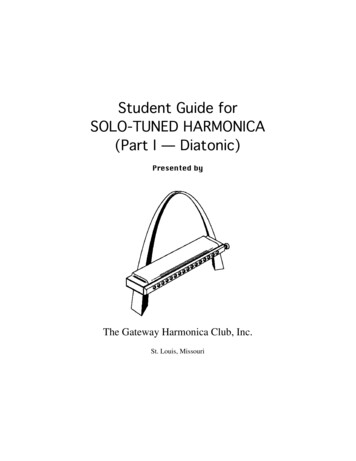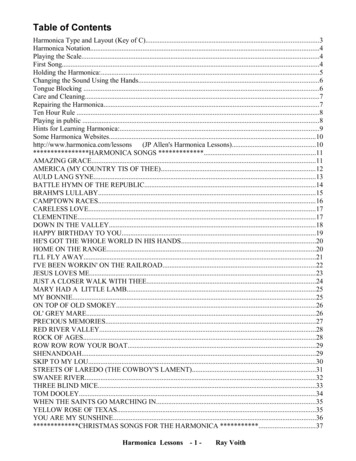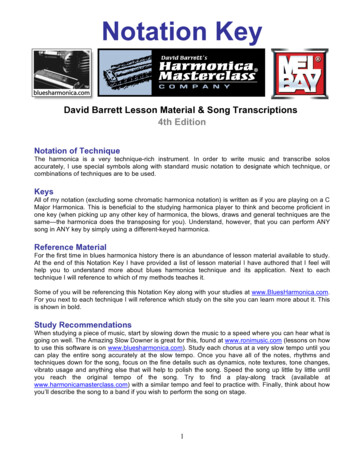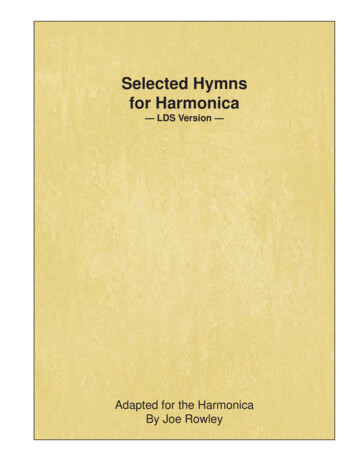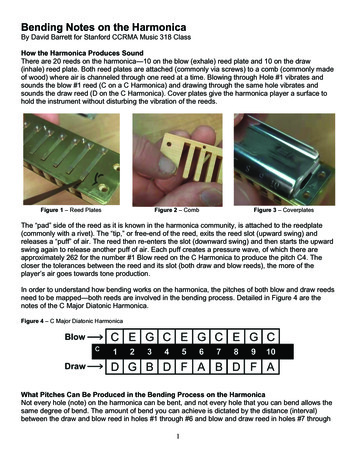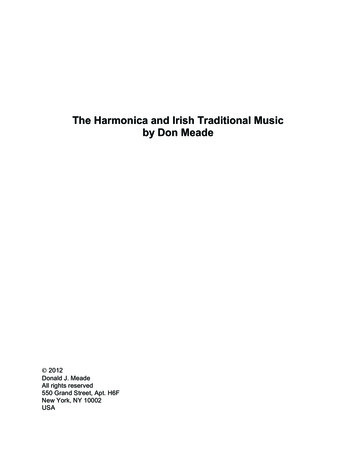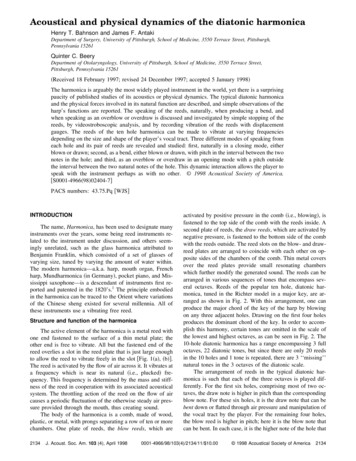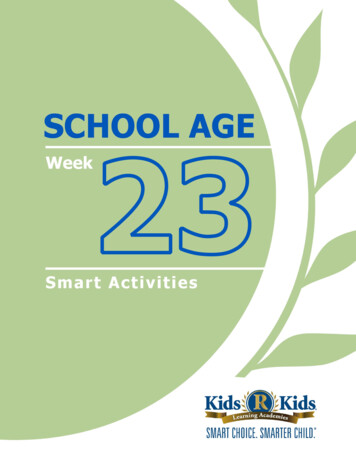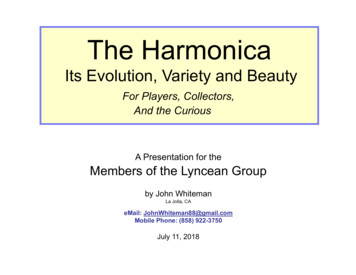
Transcription
The HarmonicaIts Evolution, Variety and BeautyFor Players, Collectors,And the CuriousA Presentation for theMembers of the Lyncean Groupby John WhitemanLa Jolla, CAeMail: JohnWhiteman88@gmail.comMobile Phone: (858) 922-3750July 11, 2018
Outline1. About harmonicas DefinitionHistory2. Harmonica as a musical instrument TypesDemonstration3. Harmonica as a “collectible” Show and tell3
Definition of “Harmonica” “Free reed” instrument that is playedby blowing/drawing with the mouth.– Also known as mouth organ (UK mostly),mundharmonika (Germany), harp Other popular free reed instruments:– Accordion (button box, concertina,handharmonika, piano accordion)– Jew’s harp– Reed organ (pump organ)– Melodica (evolved from the blow accordion)4
Standard HarmonicaI’ll explain thislaterTypical “Diatonic” Harmonica With10 holes and 20 reeds (2 per hole)(Disassembled on the next slide!)A harmonica reedOrgan reedsAirReed is “offset” from the reed plate;air must pass in direction of arrowfor reed to vibrate and make sound5
The InsidesComb – it issandwichedbetween thereed platesLower Cover PlateUpper Cover PlatePlastic: goodWood: badUpper ReedPlate Draw27 September 2017Lower ReedPlate - Blow6
Brief History of the Harmonica 1821 – first harmonica was made in Berlin frompitch pipes by Christian Buschmann – a mere 196years ago 1830 – first U.S. harmonicas made by James Bazin 1857 – Hohner starts to manufacture (700 first year) 1887 – Hohner produces 1 million per year 1920s – Golden age of harmonicas, 20 million/year 1932 – Peak production of 25m despite Depression 1938 – Recorded music and world situationdecreases Hohner production back to 20 million,steadily declining ever since; Germany eventuallycedes harmonica preeminence to Japan and China.7
Why Play a Harmonica?Very inexpensive – quitedecent for less than 5Portable – you can be anuisance anywhereVersatile – Folk songs, pop,oldies, blues, classical,religiousEasy to learn – mostharmonica players do notread music!If you’re playing the 2.29 each for 48 of these; free shippingharmonica, you don’t havewww.AndyHWeaver.comto sing!8
Why Collect Harmonicas?9
Why Collect, Indeed! Be one of the few to understand thisincredible musical instrument Have your own artifacts of 196 years ofevolution, largely undocumented 40,000 models – every collector has afew that no one else has ever seen Evolution through 2 World Wars, TheGreat Depression, Art and Customs of theday, and competition from recorded music And you can even play them if you wish10
Some Types of Harmonicas 90%Single row – Pocket harmonicaDouble row – Tremolo or octaveChromatic – Plays all notesRotaries – Multiple harmonicas on a spindleResonators – Natural amplification by horn/boxOrchestral – Bass and chord for ensemblesNovelties: Trumpet, Bell, Players, Miniatures,Blow Accordions, Patriotic/Military, Art11
The Single-row Harmonica The 10-hole diatonic – More of these than any other harmonicaDiatonic is the natural scale – Do Re Mi Fa etc.or C D E F G A B C – no sharps or flatsBasic harmonica – good to start on or stay withBlues Harp, musicians play wonderful music on these,change pitch on reeds as they playMost are in the key of C, but available in all keysVery OldOldPretty / DecoRecentNew12
The One and ONLY Lesson on Technique To play the harmonica, you must be at least be ableto play single notes And each hole has 2 single notes – blow for one,draw for the other – it’s easier than you would think(My Preference) Achieve that single note by pucker or tongue block Short demonstration: pucker vs. tongue block After you are able to play single notes by tongueblocking the notes to the left of your mouth (draggingyour tongue along the left side of harmonicamouthpiece), then you can start pulling your tongueback to play chord rhythm Short demo: melody then add rhythm & chords13
Double-row Harmonicas Tremolo – 2 reeds per note, tuned slightlyoff to give a wavering sound and echo likean accordion in a French café Octave – 2 reeds per note, tuned high andlow to give a richness and depth to notesTremolo TunedUpper hole and the hole beneathit are tuned to the same note aseach other, but one is slightly offpitch causing a vibrato soundplus an echo like an accordionOctave TunedUpper hole and the holebeneath it are tuned to thesame note as each other, butone is low and the other ishigh (an octave apart)14
Examples of Tremolo Harmonicas15
Chromatic Harmonicas Chromatic harmonicas have all the notes, like apiano – white keys and black keys (sharps and flats) Can play any melody or any harmony 3 types: double row, in-line, shiftedDouble Row ChromaticPlay through top holesfor natural notesShifted ChromaticButton out is the normalposition for “white keys”Play through bottom holes for sharps & flatsIn-Line ChromaticButton in is the position for “sharps& flats”, then it springs out again16
Rotary Harmonicas Rotary harmonicas are made of 3 or more harmonicas(usually in different keys) mounted on a spindle that can bespun to get from one to the other. They go back as far as any catalogs – over 125 years or so,and they are still being made and sold They are also called “paddle wheels”, “corncobs”, “sextets”(for 6 harmonicas), “6-way”, “6ers”, and by the Germans“Kreuzwenders”.7-way Orchestral(bass-chord)6-wayOctave4-wayTremolo27 September 20176-wayDiatonic17
Resonator/Horn HarmonicasHorn or box amplifies the sounds and also provides anopportunity to add a wah-wah effect with the handKiwanikats – c.2002Reissued in 200218
Orchestral Harmonicas Harmonicas used in “ensembles” primarily for accompaniment Bass and Chord – good players are impressive DemonstrationMelody w/Chords48 Chord: 1930s – presentBass-Chord: 1920s - present1950s – too Geeky36 Bass-Chord: 1930sPocket Bass – Extraordinary19
Now Especially For Collectors20
Estimating a Harmonica’s Age¾ Award MedallionsMadeafter 1876Made after 1869but before 1876¾ “MacDonald’s” Annual Quantity (Hohner)c.19001920s1938¾ Presence/Absence of 6-pointed Star in Hohner TrademarkMade before193827 September 2017Made after193821
Trumpet Horn Harmonicas Mostly Decorative – to sell more harmonicas Weiss Pipeolion made from 1907 to 1910 – 2 reedsinside each trumpetPipeolionReed Slit22
Bell Harps23
Player Harmonicas24
Miniature Harmonicas27 September 201725
Blow AccordionsReal Accordion c190026
Patriotic and Military ThemeDurch Kamph Zum SiegDie Wacht am Rhein – the Watch on RheinMilitar MusikMilitar MusikRussian: “to our Brothers in Arms”UnsereFlaggeGruss von Daheim – “Greetings from Home”Wenn wir MarschierenMilitar MusikUnsere MarineMilitar MusikRosemarieMilitar MusikHurra!Deutschland Erwache!“Germany Awaken!”Uncle Sam – pre WWIDeutschlands Stolz (Pride)(German Trademark registered in 1931)27
Some Favorites28
The EndThank you for invitingme to conduct this program!If you would like a copy of these “slides” in PowerPointor in pdf format, please send me an email:JohnWhiteman88@gmail.comI welcome inquiries by email or phone.29
Definition of "Harmonica" "Free reed" instrument that is played by blowing/drawing with the mouth. - Also known as mouth organ (UK mostly), mundharmonika (Germany), harp Other popular free reed instruments: - Accordion (button box, concertina, handharmonika, piano accordion) - Jew's harp - Reed organ (pump organ)
